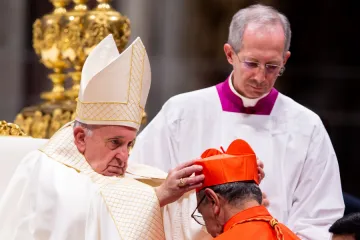Vatican City, Jun 6, 2022 / 04:46 am
Under the Code of Canon Law, reformed in 1983, there are two types of consistories of cardinals: ordinary and extraordinary.
An extraordinary consistory is celebrated in particular cases and all the world’s cardinals are called to take part.
An ordinary consistory takes place when the pope needs the cardinals’ counsel on some important (though routine) issue, or to give solemnity to a papal decision such as the approval of canonizations.
The last time that Pope Francis summoned the cardinals to an extraordinary consistory was on Feb. 12-13, 2015. Now that the new Vatican constitution has been published, the pope is once again calling the cardinals to Rome for an extraordinary consistory.
The changing face of the College of Cardinals
It is the closing of a circle. The 2015 gathering was held before the consistory for the creation of new cardinals. The extraordinary consistory on Aug. 29-30, dedicated to discussion of the constitution Praedicate evangelium, will also take place after a consistory for the creation of new cardinals.
Pope Francis has only called one other extraordinary consistory since his election in 2013. The meeting on Feb. 22, 2014, was focused on the family. It began with a speech by the German theologian Cardinal Walter Kasper that served as a baseline for discussions at the 2014-2015 Synods of Bishops on the Family.
Between 2015 and 2022, many things changed. First of all, in the College of Cardinals. By 2015, Pope Francis had created 15 cardinal electors and five non-electors. In later consistories, he created 73 other cardinals, including 48 electors. The face of the College of Cardinals has profoundly altered in recent years.
After the August consistory, there will be 132 cardinal electors and 62% will be cardinals created by Pope Francis. Many of them have not had the opportunity to talk to each other. “In the event of a conclave, I wouldn’t know who sits next to me,” complained a cardinal created during a past pontificate.
Meanwhile, Pope Francis has moved forward with a reform of the Curia that has also changed a lot over time. To understand the changes, we must go back to that extraordinary consistory of 2015, in which 164 cardinals from all over the world participated.
The 2015 extraordinary consistory
Father Federico Lombardi, then director of the Holy See press office, reported that the 2015 extraordinary consistory began with a “very broad multi-voiced report” on economic issues. Cardinal George Pell, then prefect of the Secretariat for the Economy, spoke, as did Cardinal Reinhard Marx, president of the Council for the Economy, and other figures involved in Vatican financial reform.
The next day, there was a report by the Council of Cardinals (then known as the C9) on curial reform and also an address on the internal coordination of the Curia. Cardinal Seán O’Malley then spoke about the Pontifical Commission for the Protection of Minors, which had just been established.
In the ensuing years, Vatican financial reform took steps both forward and back, which mirrored the discussion at the 2015 consistory. In fact, the financial autonomy of Vatican departments was discussed then, as well as which departments maintained a degree of independence because of their unique nature, such as the Secretariat of State and the Congregation for the Evangelization of Peoples.
In the end, however, after much trial and error, Pope Francis continued briskly with the reforms he had in mind. And perhaps it was precisely the discussions of those days, which some did not hesitate to call “resistance,” that convinced him of the need to pursue reform without consulting the wider College of Cardinals.
Father Lombardi said that there had been “a certain consensus” on the possibility of a partial implementation of some specific aspects of the reform, “without waiting for the completion of the whole work.”
(Story continues below)
That’s exactly what happened. But the use of the consistory as a sort of “papal advisory board,” as the pope had sought to do at the start of his pontificate, was suspended.
The evolution of consistories
Consistories had a particular importance in the Middle Ages. They functioned at times as a governing body, as well as a court. Pope Innocent III even convened three meetings of the cardinals per week.
After Pope Sixtus V’s reform of the Curia in the 16th century, the consistories lost the weight of government. The cardinals assisted the pope in governing the Church instead through work in the Vatican congregations, while consistories were convened to add solemnity to important moments in the Church’s life.
The consistory assumed renewed importance after the Second Vatican Council. Writing in the book “Paul VI. I saw, I believed,” Father Gianfranco Grieco said that the pope always wanted the cardinals gathered in a consistory to wait for him on his return from an international trip, to exchange first impressions of the visit with them.
John Paul II convened six extraordinary consistories during his almost 27-year pontificate, discussing themes such as the renewal of the Curia, Church, and culture, the threats against life, and the challenge of the sects.
During these meetings, the cardinals seized the chance to get to know each other, talk to each other, and understand each other’s way of thinking. The gatherings were opportunities for exchange, not just for discussion. These have been lacking in the past seven years.
The extraordinary consistory in August, therefore, will have an impact on the next conclave. But what the cardinals have to say during the formal discussions is unlikely to carry much weight. The reform of the Curia has already been completed and promulgated; the cardinals can merely take note of it.






